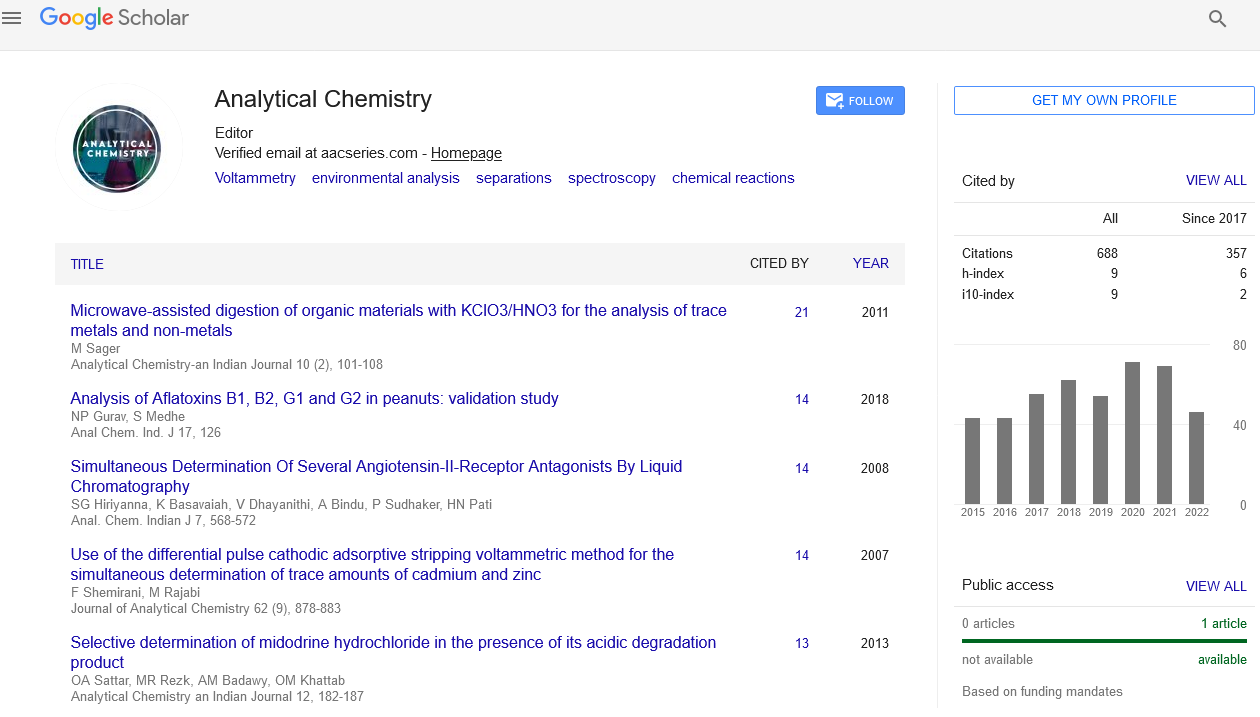Original Article
, Volume: 22( 10) DOI: 10.37532/0974-7419.2022.22(10).221Microwave approaches being used in analytical chemistry
- Corresponding Author:
- James Martin
Managing Editor, Analytical Chemistry: An Indian Journal, United Kingdom.
E-mail: martin.james45@gmail.com
Received: October 4, 2022, Manuscript No. tsac-22-83122; Editor assigned: October 6, 2022, PreQC No. - tsac-22-83122 (PQ); Reviewed: October 20, 2022, QC No. tsac-22-83122 (Q); Revised: October 22, 2022, Manuscript No tsac-22-83122 (R); Published date: October 24, 2022. DOI: 10.37532/0974-7419.2022.22(10).221
Abstract
Enhancing the sensitivity and selectivity of analytical procedures through the use of green extraction techniques is an environmentally friendly replacement for traditional sample-preparation techniques previously used. Here's an update. We examine the key methods used in the scientific literature to lessen harmful side effects of extraction methods we show that sample-treatment processes have evolved with a clear purpose. On the concurrent advancement of the method's primary analytical properties and its practical aspects, incorporating the business case. The suggested solutions meet the criteria established by the notion of sustainable development, and more precisely by putting green chemistry principles into practice in analytical labs. The discussion of potential applications of innovative, selective stationary phases in extraction techniques, thus, received special emphasis. Include silica- and carbon-based sorbents, polymeric ionic liquids, and carbon nanotubes. The methodological approaches and appropriately matched sampling tools for obtaining analyses from samples allow us to reduce the number mistakes made during sample preparation prior to chromatographic analysis and to limit the detrimental effects of this analytical step on the relationship between the natural world and laboratory workers' health.
Keywords
Analytical chemistry; Microwave techniques; Sample preparation
Introduction
There are several different microwave heating methods is applied to analytical chemistry. Sample digestion for elemental analysis, solvent extraction, and other recent developments in the use of microwave methods in the various fields of analytical chemistry. This review takes into account sample drying, moisture measurement, analyte desorption and adsorption, sample cleanup, chromogenic reaction, speciation, and nebulization of sample solutions. A review on microwave techniques does not address the use of microwave technologies in other areas of analytical chemistry, such as microwave plasma atomic spectrometry and microwave spectrometry because of the enormous effects of human presence on the world, there is an urgent need for all of our actions to be sustainable.
Expedited the shift from the chemurgical paradigm to the ecological paradigm, where the impacts of our actions on the environment are considered. Chemical actions need to be carefully considered. Green analytical chemistry and green chemistry there is a transition from the academic realm to the real world. The amazing study being done on greening every element of the examination of any samples, not just environmental samples studies. We are positive that GAC will be incredibly helpful. In theupcoming years. The use of affordable, quick, and ecologically friendly methods for environmental, medical, and food analysis will raise living standards in emerging nations.
The paper noted that the continued advancement of human fulfilment of socioeconomic demands and civilization. Only if the natural resources are preserved will the current generation be able to correctly conduct and the connection between economic expansion while preserving the environment and the current generation's health, It is intentionally maintained for future generations, although the long-term The results of industrial activity are also taken into account. The specific Relevance is connected to the adoption of sustainable progress in the laboratory and professional lives of chemists and on a commercial scale.
Conclusion
Many things have been affected by microwave technology. Analytical chemistry fields. Using a microwave under specific circumstances, radiation can significantly speed the rate of sample mineralization (such as digestion), the equilibrium of the analyte distribution in Chemical processes (such as chromogenic reactions), two phases (such as extraction, desorption, adsorption, and cleanup), the rate at which water is heated (in the determination of moisture and thermospray), and this technique's application to sample preparation and flow injection analysis looks promise.

